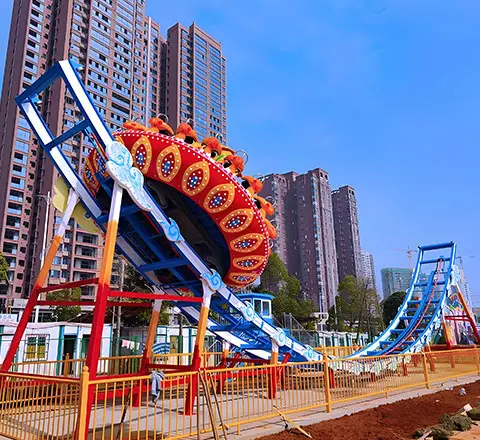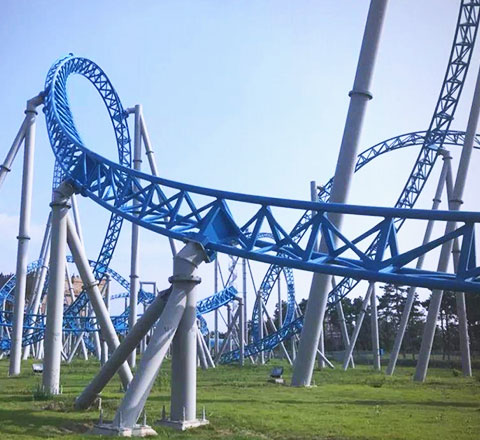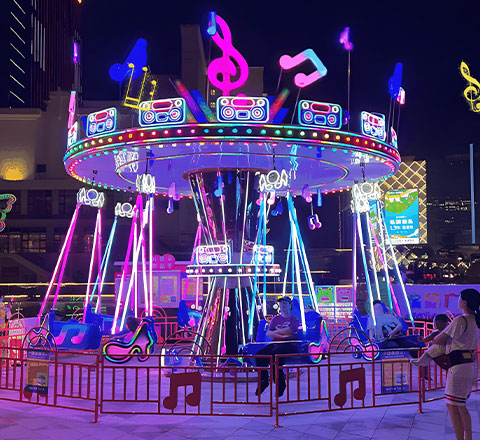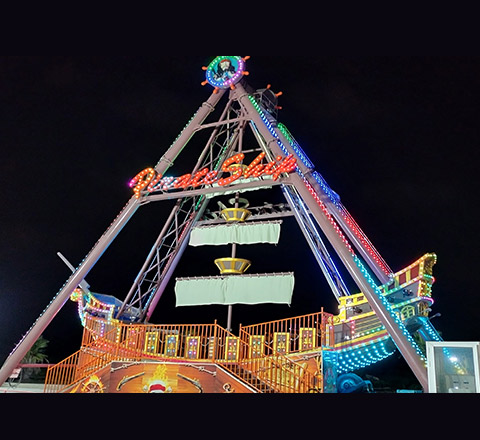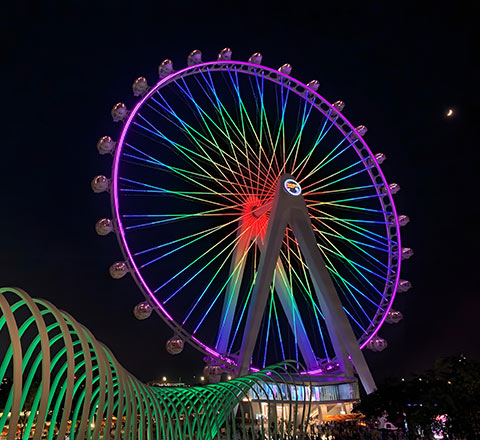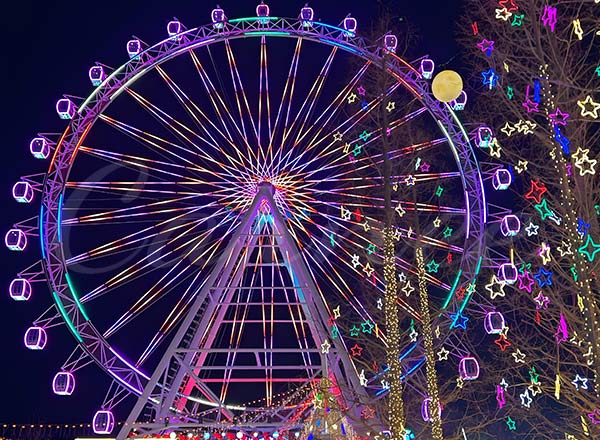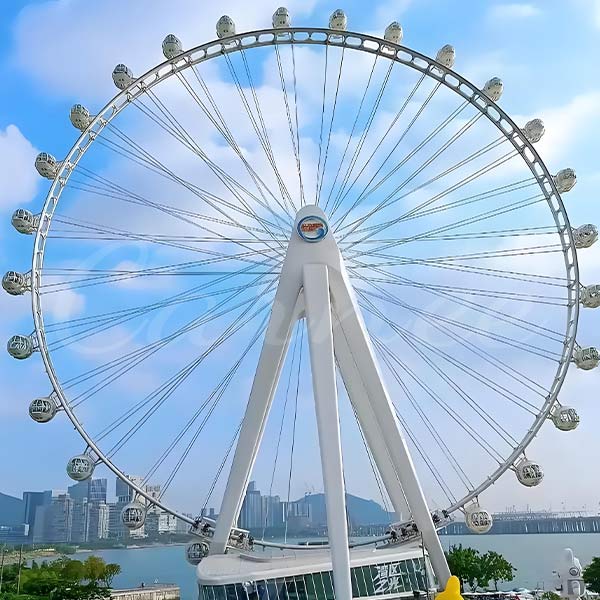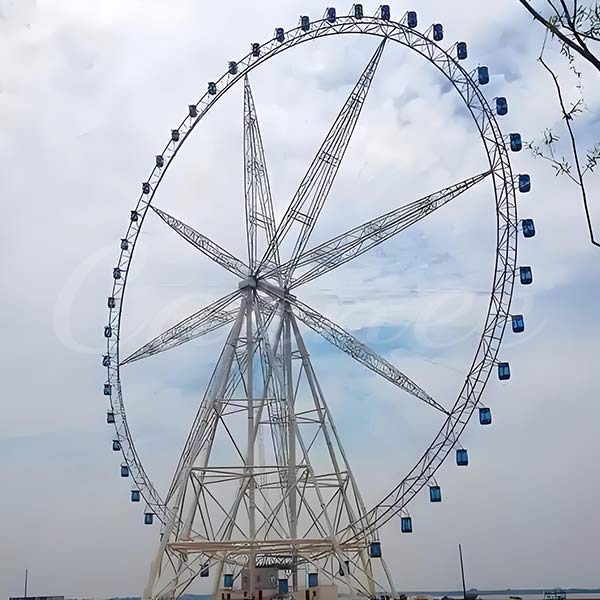Ferris wheels are one of the top 10 most popular amusement park rides. Whether as an entertainment attraction or a city landmark, Ferris wheels have immense appeal and visual impact. So, how much do Ferris wheels cost? This article will guide you through the pricing structure of Ferris wheels and the factors that influence their cost, helping you make an informed investment decision.
Ferris Wheel Price Range
The cost of a Ferris wheel varies greatly depending on its size, design, passenger capacity, and technical requirements. Below is a price range for common types of Ferris wheels:
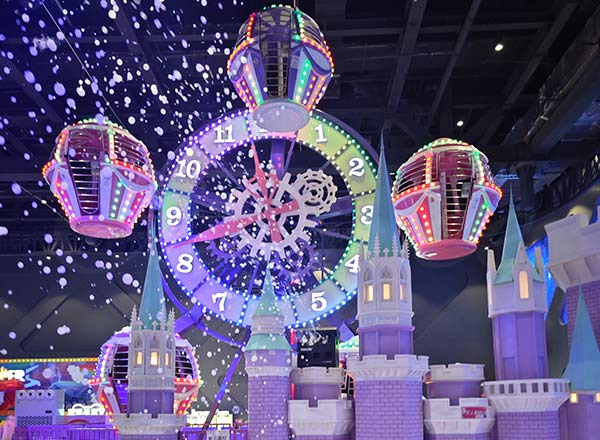
| Type | Height | Price Range (USD) | Applicable Locations | Features |
| Small Ferris Wheel | 6 – 20 meters | $8,000 – $28,000 | Children’s Play Areas, Shopping Centers, Small Amusement Parks | Ideal for children, compact design, easy to install, visually attractive. |
| Medium Ferris Wheel | 30 – 50 meters | $38,000 – $78,000 | Small to Medium Amusement Parks, City Parks | Larger capacity, suitable for families and medium tourist traffic, rich design suitable for long-term operations. |
| Large Observation Ferris Wheel | 50 meters and above | $145,000 – $320,000 | Large Amusement Parks, City Landmarks | Large capacity, broad views, unique design with high-end cabins and lighting decorations. |
| Giant Ferris Wheel | 100 meters and above | $520,000 – $1,500,000 | Tourist Attractions, City Landmarks | Highly iconic, suitable for large tourist traffic, typically equipped with top-tier facilities and safety systems. |
Factors Affecting the Price of a Ferris Wheel
The price of a Ferris wheel is influenced by several factors, and here are some of the most important ones:
1. Size and Height of a Ferris Wheel
The Ferris wheel height is a major factor in determining its price. Taller Ferris wheels typically require more materials and more complex engineering designs, thus making them more expensive. Depending on the viewing effect and passenger capacity needed, Ferris wheel heights can range from 20 meters to 120 meters, with significant price differences. (See More: Ferris Wheel Dimensions: Sizes, Heights & Design Features)
2. Customization and Design
Custom designs are one of the key factors affecting the price of a Ferris wheel. Although customized designs can greatly enhance the attraction and functionality of a Ferris wheel, they also add significant costs. Customization involves additional costs for design, materials, and production processes. Furthermore, customized facilities and decorations require more technical support and installation work, resulting in higher labor and specialized equipment costs.
Overall, custom designs usually increase the cost of a Ferris wheel by 30%-50% or more compared to standard models. For investors looking to create a unique amusement experience or landmark building, this extra investment may be worthwhile, but a careful balance between budget and expected return is needed.
Let’s take a look at the customization options available for Ferris wheels.
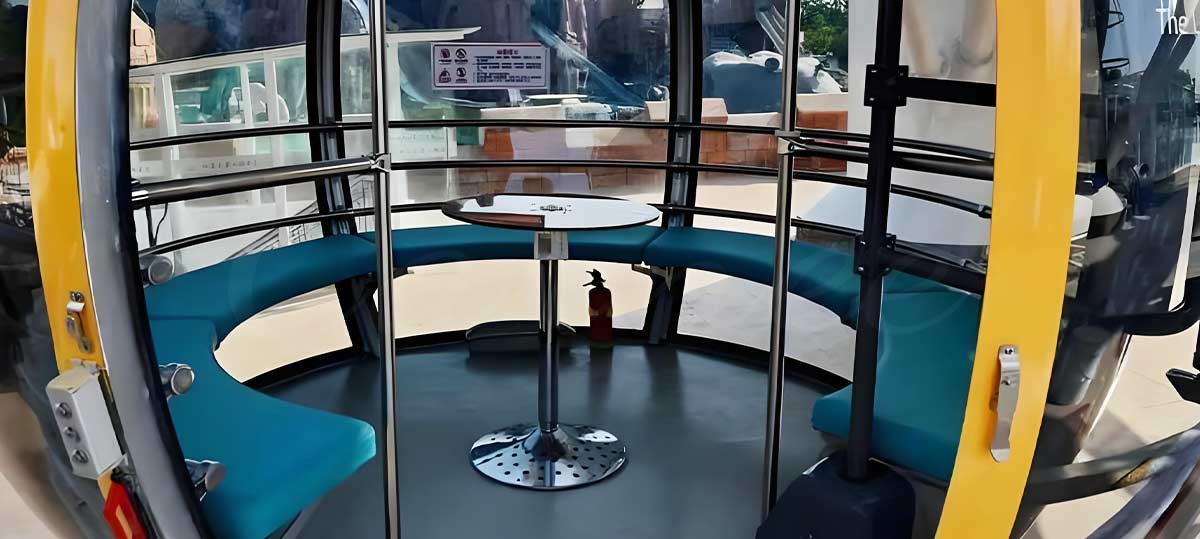
2.1 Cabin Design
The cabins of Ferris wheels are one of the most distinctive parts of a Ferris wheel. Traditional Ferris wheel cabins are typically simple glass windows and metal structures, but through customization, they can become more luxurious and unique. Examples include:
- Luxury Cabins: Some high-end Ferris wheels offer luxury cabins that feature air conditioning, comfortable seating, interior decorations, and even dining services. These cabins often use high-end materials such as leather seating, wood paneling, and transparent glass floors, allowing visitors to enjoy the surrounding views more comfortably. Luxury cabins significantly increase the cost of the Ferris wheel.
- Private Booths: To cater to high-end markets, some Ferris wheels offer private booths for families or small groups. These booths come with unique interior features such as televisions, sound systems, and even personal tour guides. The complexity of designing and the cost of private booths are higher than standard cabins.
2.2 Lighting and Decorations
The lighting system of a Ferris wheel not only enhances its aesthetic at night but also strengthens its role as a city landmark. A customized lighting system can be adapted for holiday events or specific occasions, and it can even synchronize with the lighting effects of surrounding city buildings. Common customized Ferris wheel lighting designs include:
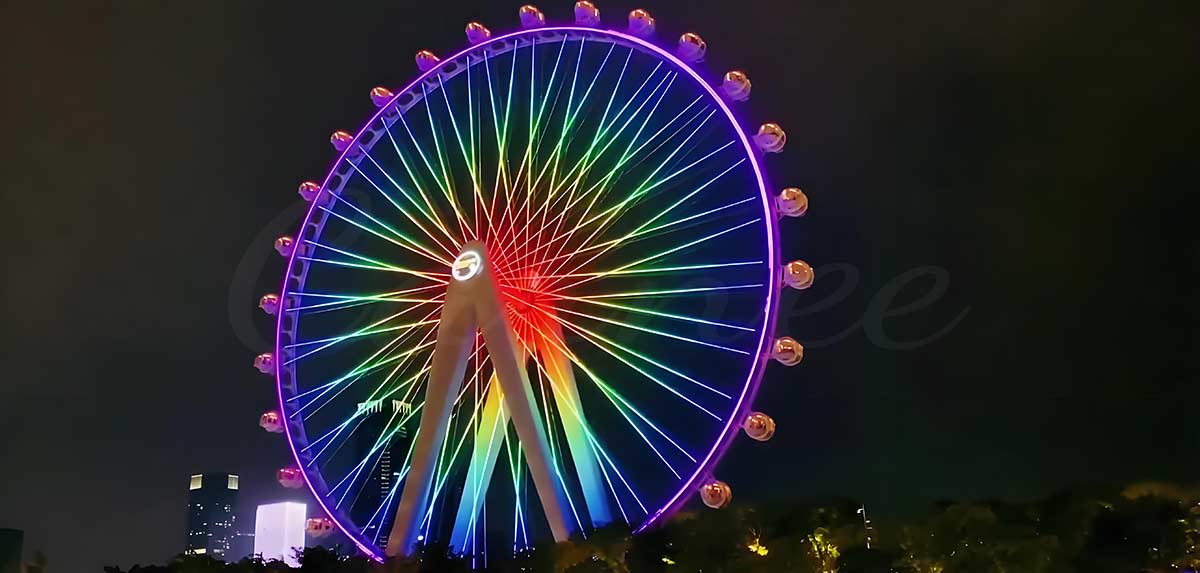
- LED Strips: By using high-brightness LED strips, the Ferris wheel ride can present colorful effects at night, attracting visitors’ attention.
- Ferris wheel light show: Some Ferris wheel amusement rides can adjust their lighting colors based on different occasions. For instance, during holiday seasons, the Ferris wheel’s lights may be switched to red and green, or brand colors may be used during major events. This customized lighting system requires additional design and control systems, increasing installation and maintenance costs.
2.3 Theme Design
Customization can also extend to the overall appearance and theme of the Ferris wheel. Depending on the culture and positioning of the amusement park or city, Ferris wheels can be designed with unique themes. For example:
- Cultural Themes: Some Ferris wheels may incorporate local historical and cultural elements in their design. For example, a Ferris wheel in China may feature traditional Chinese elements, such as dragon-shaped decorations or red lanterns, while Ferris wheels in Europe may incorporate classical architectural styles.
- Modern Technology Themes: Ferris wheels can also combine modern technology, using futuristic designs and smart interactive systems. Some Ferris wheels have the appearance of spacecraft, flying machines, or other tech-inspired designs to appeal to younger visitors and technology enthusiasts.
2.4 Additional Facilities
In addition to the basic design and customization, extra facilities in the Ferris wheel can also increase its cost. Examples include:
- Entertainment Systems: Some high-end Ferris wheels are equipped with multimedia entertainment systems, such as built-in sound systems, video screens, and interactive touchscreens, to enhance the visitor experience during the ride.
- Dining Services: Some luxurious Ferris wheels provide dining services, allowing visitors to enjoy meals at high altitudes. This customized service often increases the initial investment and operating costs of the Ferris wheel.
3. Passenger Capacity
The capacity of a Ferris wheel directly impacts its manufacturing cost. More cabins and larger carrying capacity require more materials and a more complex structure, so larger Ferris wheels are typically more expensive. High-end designs may offer luxury cabins and additional facilities, further increasing the price.
Most amusement parks and entertainment facilities opt for medium-sized Ferris wheels, which are typically simple in design and have moderate passenger capacity, catering to a larger number of visitors. These medium-sized Ferris wheels are typically between 20 to 50 meters tall and have a passenger capacity ranging from a few dozen to several hundred people. They offer a balance of price, functionality, and operational costs.
Large landmark Ferris wheels are rarer and tend to have unique designs, larger scales, and often become city landmarks. The Top 10 Ferris Wheels in the World typically fall into this category, with their heights, capacities, and architectural structures far exceeding those of standard Ferris wheels. For example, the Ain Dubai and the High Roller in Las Vegas belong to this category.
When considering building a Ferris wheel science project, investors must decide whether to choose a medium-sized or small Ferris wheel suited for amusement parks or go for a big Ferris wheel.
4. Facilities and Technology
The technical requirements for a Ferris wheel are also an important cost factor. The drive system, supporting structure, and materials used for the cabins require high levels of technical expertise. Advanced technologies such as automated control systems, precision safety systems, and eco-friendly ferris wheel materials will also increase the overall cost.
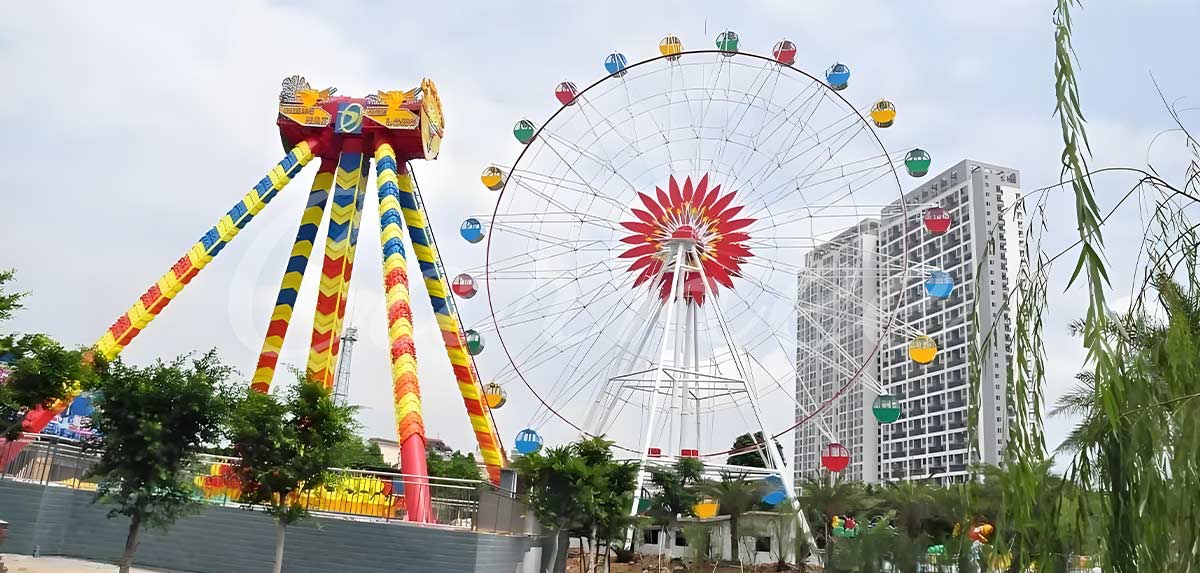
Installation and Transportation Costs of Ferris Wheel
In addition to the purchase cost, the installation and transportation costs are important considerations. Ferris wheels often require specialized equipment and construction teams, leading to higher transportation and installation costs. For large Ferris wheels, cranes, and special transportation vehicles may be necessary to move heavy components.
1. Transportation and Logistics
The components of a Ferris wheel are typically large and heavy, requiring special transportation arrangements. International shipping fees, as well as the loading and unloading of large components, can add significant costs.
2. Installation and Assembly
The Ferris wheel installation requires a professional engineering team to handle the process. The complexity of the installation depends on the size and design of the Ferris wheel, and it typically takes several months to complete.
3. Site Preparation
To install a Ferris wheel carnival ride, site preparation is necessary, including the construction of infrastructure, electrical system integration, and surrounding environmental work. These factors add additional investment costs.
Ferris Wheel Investment Return Analysis
Despite the high initial investment, Amusement Park Ferris wheels can provide significant returns for your amusement park or tourist attraction. Ferris wheels are not only major attractions in amusement parks but also iconic landmarks for cities, drawing large numbers of visitors. The revenue from operating a Ferris wheel mainly comes from ticket sales, and some high-end Ferris wheels can also generate extra income through advertising and light shows.
1. Ticket Revenue
Assuming your Ferris wheel ride can accommodate 50 people per ride, operates 10 hours a day, and runs 4 times an hour, the daily income could be several thousand dollars. As visitor numbers increase and ticket prices adjust, the revenue from the Ferris wheel is likely to grow.
2. Additional Revenue
Some high-end Ferris wheels offer additional sources of income, such as nighttime light shows, VIP cabins, and advertising space for rent. These extra revenue streams can further increase the return on investment.
Key Considerations When Buying a Ferris Wheel (continued)
When purchasing a Ferris wheel, there are several key factors to consider to ensure a return on investment and long-term operational success. Here are the critical elements to keep in mind when buying a Ferris wheel:
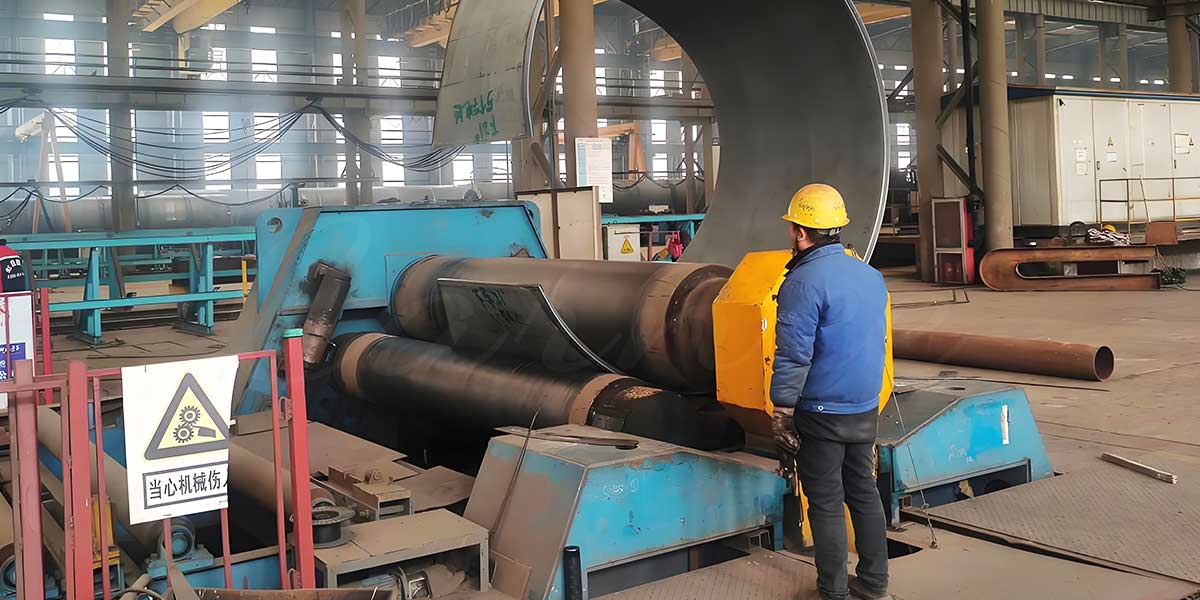
1. Choose the Right Manufacturer
It is essential to select an experienced and reputable Ferris wheel manufacturer. A good amusement ride manufacturer can provide high-quality equipment, as well as professional amusement park design planning, project management, and after-sales service. Before purchasing, be sure to check the manufacturer’s credentials, customer feedback, and successful case studies.
2. Location is Key
The success of a Ferris wheel largely depends on its location. Choose a location with high foot traffic and strong purchasing power, such as city centers, tourist attractions, or theme parks, to ensure that the Ferris wheel attracts enough visitors. The location also determines whether the Ferris wheel will become a landmark, giving your investment more exposure and long-term profitability.
3. Budget Planning
Investing in a Ferris wheel fair ride requires substantial financial backing, covering costs for purchasing the equipment, construction, installation, and operations. Before investing, understand the cost structure of the Ferris wheel and set a clear budget. Ensure that you have enough funds to avoid cash flow issues during construction or operation. Additionally, it is essential to reserve some emergency funds to address any unexpected costs or risks.
4. Ensuring Safety and Quality Certification
Safety is the top priority when purchasing a Ferris wheel, as it is a high-altitude amusement facility. When purchasing, make sure the Ferris wheel meets relevant safety standards and certifications. Ensure that its design, materials, structure, and operational systems conform to international safety standards. A reputable Ferris wheel manufacturer will provide valid quality assurance and safety certification documents.
5. Understanding After-Sales Service and Maintenance Needs
It is crucial to inquire whether the manufacturer offers comprehensive after-sales service and ferris wheel maintenance support. Ensure that they have a robust system in place for handling maintenance, troubleshooting, and spare parts replacement, as these services are vital for the long-term operation of the Ferris wheel.
6. Evaluating Market Demand and Profit Potential
In addition to the purchase and installation costs, it is essential to assess the market demand and profit potential that the Ferris wheel will generate. Evaluate visitor traffic at the installation site to determine whether the Ferris wheel will attract enough visitors and generate substantial ticket revenue. Additionally, assess potential for additional income sources, such as advertising revenue, nighttime light shows, and surrounding facility synergy, which could boost the profitability of the Ferris wheel.
7. Considering Future Upgrades
With the continuous development of technology and entertainment demands, Ferris wheel designs and features may require periodic upgrades. For example, adding new interactive features, enhancing cabin comfort, or integrating virtual reality technology could improve the attraction. When purchasing, it is also important to consider future maintenance and upgrade needs to ensure the Ferris wheel remains attractive and competitive in the years to come.

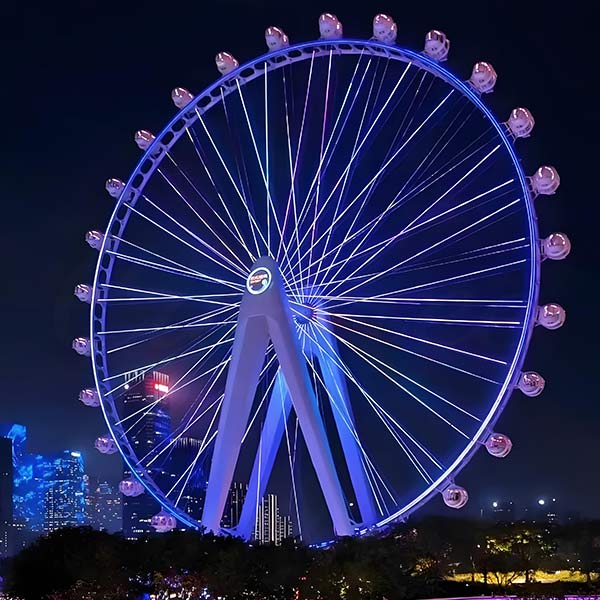
FAQ (Frequently Asked Questions)
For more faq: Ferris Wheel FAQ: 20 Common Questions Answered
Conclusion
The price of a Ferris wheel varies greatly based on its size, design, features, and installation conditions. Purchasing a Ferris wheel is a significant investment decision that involves multiple considerations. Choosing the right manufacturer, understanding installation and transportation costs, ensuring safety, evaluating operational and maintenance requirements, and considering future market demand and profitability potential are all critical factors to ensure the success of your Ferris wheel investment.
If you are considering buying a Ferris wheel, feel free to contact us. As a leading Ferris wheel manufacturer in China, we will provide personalized designs and the most competitive prices according to your needs, helping you achieve quick returns.

